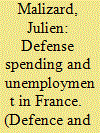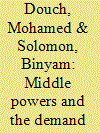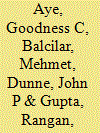|
|
|
Sort Order |
|
|
|
Items / Page
|
|
|
|
|
|
|
| Srl | Item |
| 1 |
ID:
134025


|
|
|
|
|
| Publication |
2014.
|
| Summary/Abstract |
The paper presents an analysis of the factors explaining the export performance of firms in the defence sector. We focus on the case of Norway, and make use of two complementary methodologies: the first is based on econometric firm-level data analysis for the whole population of defence companies, and the second is based on qualitative case study research on the three most important defence export products (weapon stations, ammunition and electronics). Our empirical results highlight the importance of four major success factors for exporting firms: (1) the participation in offset agreements; (2) the ability to focus on their set of core competencies; (3) their R&D activities and interactions with the public S&T system; and (4) demand opportunities and, relatedly, user-producer interactions.
|
|
|
|
|
|
|
|
|
|
|
|
|
|
|
|
| 2 |
ID:
134024


|
|
|
|
|
| Publication |
2014.
|
| Summary/Abstract |
Collaborative defence projects have been a distinctive feature of European defence industrial policy. This article focuses on whether the number of partner nations in international collaborative defence and aerospace programmes is a source of inefficiency. It appears that there is not a simple linear relationship. Two nation collaborations can be efficient, but conventional wisdom assumes that inefficiencies emerge with more than two partner nations. Inevitably, data problems made what appears to be a simple hypothesis difficult to test. The major result is that there is no evidence that efficiency as measured by development times is adversely affected by the number of partner nations. A limited sample regression and a comparison of Airbus vs. Boeing shows a similar conclusion.
|
|
|
|
|
|
|
|
|
|
|
|
|
|
|
|
| 3 |
ID:
134029


|
|
|
|
|
| Publication |
2014.
|
| Summary/Abstract |
France has received little attention in the literature of defense economics, despite some outstanding features of the country's situation. This study attempts to partially fill this gap with new empirical evidence which evaluates the influence of military expenditure on the unemployment rate between 1975 and 2008. Our estimation is based on the ARDL approach to cointegration. The results reveal that both defense and non-defense spending exert a negative influence on unemployment but that defense spending has a higher negative impact.
|
|
|
|
|
|
|
|
|
|
|
|
|
|
|
|
| 4 |
ID:
134026


|
|
|
|
|
| Publication |
2014.
|
| Summary/Abstract |
Budgetary restrictions resulting from the present international economic crisis have tightened the need to improve efficiency in defense spending, leading to the armed forces having to undertake their duties with fewer resources. Previous reports on the subject have looked into the determining factors and effects of military spending but very few studies have analyzed the determinants for the modernization of the methodology for assessing efficiency. Thus, using a multiple regression statistical model, we have analyzed the appraisal systems in place in 28 countries to identify factors that influence the development of economic assessment of military expenditure. Our findings have revealed three factors that may favor the improvement of appraisal systems with regard to military expenditure: the quality of governance, size of the armed forces, and unemployment levels.
|
|
|
|
|
|
|
|
|
|
|
|
|
|
|
|
| 5 |
ID:
134027


|
|
|
|
|
| Publication |
2014.
|
| Summary/Abstract |
This paper identifies and classifies middle power nations through the use of broad political science definitions, the demand for military expenditures models and gross domestic product (GDP) per capita. The latter is used as a simple quantifiable measure of relative and potential military power. The paper also develops and utilizes a threat variable that is applicable to middle power nations. The panel data analysis shows that the middle power nations react to threat variables that proxy global instability utilize foreign aid as a complementary policy tool along with military expenditures, and face significant trade-offs between military and non-military government spending.
|
|
|
|
|
|
|
|
|
|
|
|
|
|
|
|
| 6 |
ID:
134028


|
|
|
|
|
| Publication |
2014.
|
| Summary/Abstract |
This paper contributes to the growing literature on the milex-growth nexus, by providing a case study of South Africa and considering the possibility of structural breaks by applying newly developed econometric methods. Using full sample bootstrap Granger non-causality tests, no Granger causal link is found between military expenditure and GDP for 1951-2010, but parameter instability tests show the estimated VARs to be unstable. Using a bootstrap rolling window estimation procedure, however, finds evidence of bidirectional Granger causality in various subsamples. This implies standard Granger non-causality tests, which neither account for structural breaks nor time variation may be invalid.
|
|
|
|
|
|
|
|
|
|
|
|
|
|
|
|
|
|
|
|
|